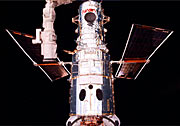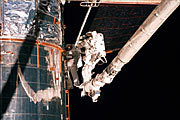Servicing Mission 2
|
After a successful first mission to correct Hubble’s vision in 1993, a second Servicing Mission (STS-82) was launched to the space telescope in February 1997. The goal of this 10-day operation was to enhance Hubble’s scientific capabilities for discovery by conducting a number of maintenance tasks and refurbishing the existing systems. STS-82 included the installation of two technologically advanced instruments by a crew of astronauts who reached Hubble aboard the Discovery Space Shuttle. Both devices featured technology that was not available when the first designs of the Hubble Space Telescope were produced. The Near Infrared Camera and Multi-Object Spectrometer (NICMOS) and the Space Telescope Imaging Spectrograph (STIS) replaced the Faint Object Spectrograph (FOS) and the Goddard High Resolution Spectrograph (GHRS) respectively. NICMOS has enabled astronomers to dig into the nature of dusty galactic centres and to gain valuable knowledge of star and planet formation. Consisting of three cameras, NICMOS has proven effective at providing infrared and spectroscopic observations of cosmological objects. One of NICMOS’s key contributions is having presented the world with the first image of our Universe at near-infrared wavelengths. These wavelengths are not observable to the human eye, but allow us to probe the distant Universe. Endowed with powerful detectors, NICMOS has been able to offer views of our Universe that no other previous optical or ultraviolet device has ever been capable of. STIS is a powerful spectroscopic device sensitive to light in ultraviolet wavelengths. It employs two-dimensional detectors that gather 30 times more spectral data and 500 times more spatial data than the first generation Hubble spectrographs. STIS is considered to be the most complex scientific instrument built for space science. With its high sensitivity and resolution, scientists have studied the distribution of mass across the Universe, star formation in faraway galaxies, and supermassive blackholes. Additionally, astronauts replaced and renewed primary spacecraft hardware:
The seven-member crew of astronauts who conducted five spacewalks during this mission were equipped with more than 150 crew aids and tools.
Links |
Hubble after capture with the remote manipulator arm. Ready for surgery! Astronauts Lee and Smith repairing parts of Hubble's insulation. |

